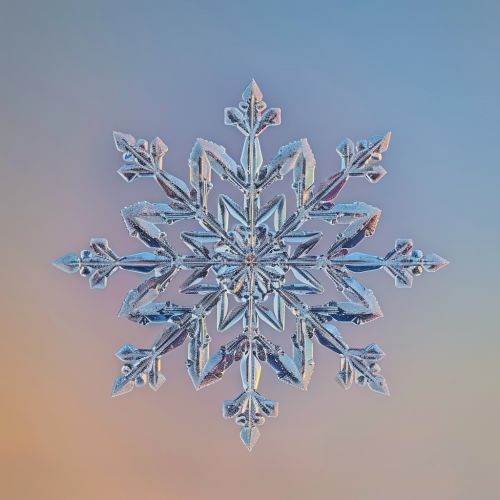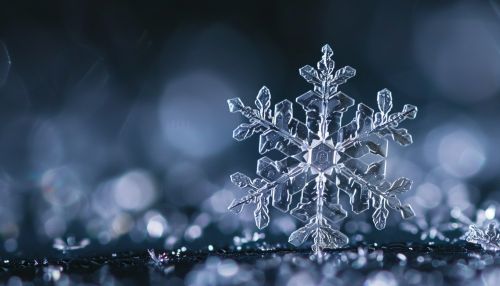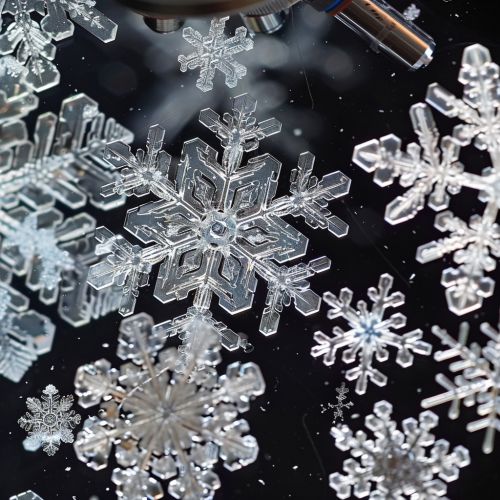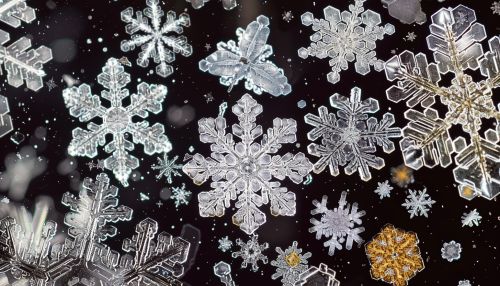Snowflake
Introduction
A snowflake is a single ice crystal that has achieved a sufficient size, and may have amalgamated with others, then falls through the Earth's atmosphere as snow. Each flake nucleates around a dust particle in supersaturated air masses by attracting supercooled cloud water droplets, which freeze and accrete in crystal form. Complex shapes emerge as the flake moves through differing temperature and humidity zones in the atmosphere, such that individual snowflakes differ in detail from one another, but may be categorized in eight broad classifications and at least 80 individual variants. The main constituent shapes for ice crystals, from which combinations may occur, are needle, column, plate, and rime.


Formation
Snowflakes form when tiny supercooled cloud droplets (about 10 μm in diameter) freeze. These droplets are able to remain liquid at temperatures lower than −18 °C (0 °F), because to freeze, a few molecules in the droplet need to get together by chance to form an arrangement similar to that in an ice lattice. Then the droplet freezes around this "nucleus". Experiments show that this "homogeneous" nucleation of cloud droplets only occurs at temperatures lower than −35 °C (−31 °F). In warmer clouds an aerosol particle or "ice nucleus" must be present in (or in contact with) the droplet to act as a nucleus. Ice nuclei are very rare compared to that cloud condensation nuclei on which liquid droplets form. Clays, desert dust and biological particles may be effective, although to what extent is unclear. Artificial nuclei include particles of silver iodide and lead iodide.
Structure and Classification
Snow crystals form when tiny supercooled water droplets freeze onto ice nuclei. As the droplets freeze, more water vapor condenses onto the ice crystal, causing it to grow. The intricate shape of a single arm of a snowflake is determined by the atmospheric conditions experienced by the entire ice crystal as it falls. A crystal might begin to grow in one manner, and then minutes or even seconds later, slight changes in the surrounding temperature or humidity causes the crystal to grow in another way. Although the ice is clear, scattering of light by the crystal facets and hollows/imperfections mean that the crystals often appear white in color due to diffuse reflection of the whole spectrum of light by the small ice particles.
Types of Snowflakes
There are a number of classifications for snowflakes:
1. Column crystals – These are shaped like six-sided columns. 2. Plane crystals – These are flat, six-sided and often intricately detailed. 3. Combination of column & plane crystals – These are a combination of the above two types. 4. Rimed snowflakes – These are created when water droplets collide with a crystal, leading to the formation of a glazed covering. 5. Germs – These are incomplete, typically smaller snowflakes. 6. Irregular snowflakes – These are irregularly shaped snowflakes. 7. Double snowflakes – These are snowflakes that are stuck together.


Snowflake Symmetry
A non-aggregated snowflake often exhibits six-fold radial symmetry. The initial symmetry can occur because the crystalline structure of ice is six-fold. The six "arms" of the snowflake, or dendrites, then grow independently, and each side of each arm grows independently. Most snowflakes are not completely symmetric. The micro-environment in which the snowflake grows changes dynamically as the snowflake falls through the cloud, and tiny changes in temperature and humidity affect the way in which water molecules attach to the snowflake. Indeed, it is unlikely that any two snowflakes are alike due to the estimated 10^19 (10 quintillion) water molecules which make up a typical snowflake, which grow at different rates and in different patterns depending on the changing temperature and humidity within the atmosphere that the snowflake falls through on its way to the ground.
